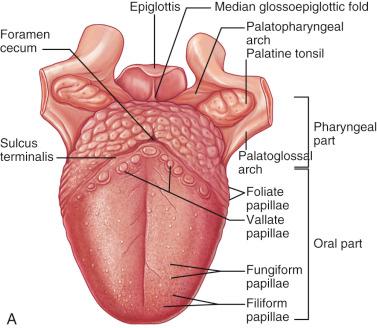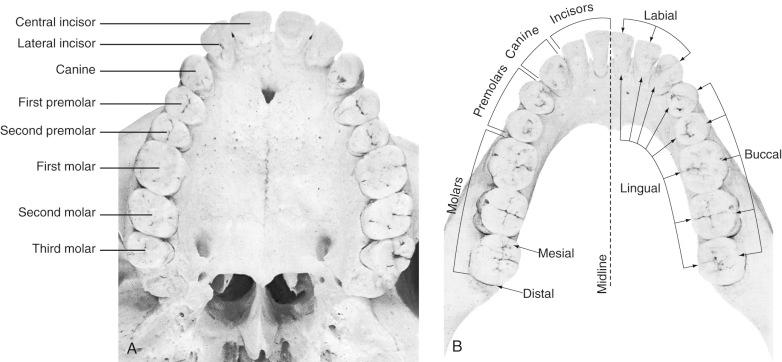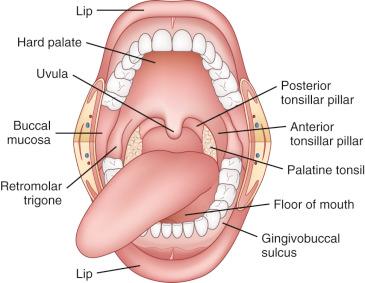Physical Address
304 North Cardinal St.
Dorchester Center, MA 02124
Primitive mouth or stomodeum develops partly from the surface ectoderm and partly from the endoderm of the cranial end of the foregut (the future site of the pharynx):
Initially, the oropharyngeal membrane separates these structures, but at the end of the fourth week of gestation the oropharyngeal membrane disappears, allowing for direct communication of the mouth with the pharynx.
Most of the epithelium of the oral cavity (lips, gums, palate) are of ectodermal origin.
Epithelium of tongue varies in its development:
Anterior two thirds of oral tongue is of ectodermal origin, developing from the tuberculum impar (median tongue bud or swelling), and is of first branchial arch derivation.
Posterior or pharyngeal portion of the tongue is of endodermal origin, developing from the hypobranchial eminence, and is of third branchial arch derivation.
Muscles of mastication (temporalis, masseter, and medial and lateral pterygoids) are derived from the first branchial arch (mandibular arch).
Mandible is formed from the mandibular prominence of the first branchial arch.
Maxilla, zygomatic bone, and squamous part of the temporal bone derive from the maxillary prominence of the first branchial arch.
Nerves:
Trigeminal nerve (V) (maxillary and mandibular branches) arises from the first branchial arch.
Facial nerve (VII) arises from the second branchial arch.
Glossopharyngeal nerve (IX) arises from the third branchial arch.
Vagus nerve (X) arises from the fourth branchial arch.
Structures within the anatomic confines of the oral cavity ( Fig. 4-1 ) include:
Lips:
Mucosal lip begins at the junction of the vermilion border with the skin and includes only the vermilion surface or that portion of the lip that comes in contact with the opposing lip.
Vermilion border represents the junction between the skin and the oral mucosa.
Oral vestibule:
Slit-like space between the lips or cheeks on one side and teeth on the other side
When teeth occlude the vestibule is a closed space that only communicates with the oral cavity proper in retromolar region behind the last molar tooth on each side.
Mucosa that covers the alveolus of the jaw is reflected onto the lips and cheeks; a trough or sulcus is formed called the fornix vestibuli.
In midline there are upper and lower labial frena or frenula.
Upper frenula attached well below alveolar crest
Buccal mucosa (cheeks):
Includes all the membrane lining of the inner surface of the cheeks and lips from the line of contact of the opposing lips to the line of attachment of mucosa of the alveolar ridge (upper and lower) and pterygomandibular raphe
Floor of mouth:
Semilunar or horseshoe-shaped area situated beneath the movable tongue between the upper alveolar ridge and the mucous membrane covering the palatine process of the maxillary palatine bones
Extends from the inner surface of the superior alveolar ridge to the posterior edge of the palatine bone
A fold of tissue, lingual frenulum, extends from the inferior surface of tongue near the base of the tongue.
Submandibular ducts open into the mouth at the sublingual papilla (caruncle), which is a large positioned protuberance at the base of the tongue.
Retromolar trigone:
Attached mucosa overlying the ascending ramus of the mandible from the level of the posterior surface of the last molar tooth to the apex superiorly, adjacent to the tuberosity of the maxilla
Tongue ( Fig. 4-2 ):
Highly muscular organ of deglutition, taste, and speech
Attached by muscles to hyoid bone, mandible, styloid process, soft palate, and pharyngeal wall
Has root, apex, curved dorsum, and inferior (ventral) surface
Dorsal tongue:
Represents the superior surface related to hard and soft palates
Located in floor of the oral cavity
Generally convex in all directions at rest
Divided by V -shaped sulcus terminalis into anterior (oral or presulcal) part, which faces upward, and posterior (pharyngeal or postsulcal) part, which faces posterior
Oral (presulcal) tongue:
Anterior two thirds of tongue lying in floor of oral cavity
Freely mobile portion
Extending anteriorly from the line of circumvallate papillae to the undersurface of the tongue at the junction of the floor of the mouth
Covered by numerous papillae, some of which bear taste buds
Pharyngeal (postsulcal) part:
Posterior one third of tongue representing its base lying posterior to palatoglossal arches
Forms anterior wall of oropharynx
Mucosa reflects laterally onto palatine tonsils and pharyngeal wall and posteriorly onto the epiglottis by glossoepiglottic folds surrounding two depressions or valleculae
Devoid of papillae
Underlying lymphoid nodules embedded in submucosa collectively referred to as lingual tonsil
In situations in which the thyroid does not migrate during development, it remains in postsulcal part of the tongue (lingual thyroid, see Section 8)
Ventral surface of tongue:
Represents the undersurface (nonvillous ventral surface)
Visible when the tip of the tongue is turned upward

Palatine bone:
Posteriorly placed in nasal cavity between maxillae and pterygoid processes of the sphenoid bones
Contribute to:
Floor and lateral walls of the nose
Floor of the orbit
Hard palate
Pterygopalatine and pterygoid fossae
Inferior orbital fissure
Each palate bone has:
Two plates (horizontal and perpendicular) arranged as L -shaped
Three processes: pyramidal, orbital, and sphenoidal
Hard palate:
Semilunar area between the upper alveolar ridge and the mucous membrane covering the palatine process of the maxillary palatine bones
Extends from the inner surface of the superior alveolar ridge to the posterior edge of the palatine bone
Soft palate:
See Section 3, Pharynx.
Gingivae (gums):
Lining mucosa of the (inner) cheeks
Gnathic (jaw) bones:
Include maxilla and mandible
Maxilla:
Largest of facial bones (other than the mandible) that jointly form the whole of the upper jaw
Each maxillary bone forms the greater part of the floor and lateral wall of the nasal cavity, floor of orbit, contributes to the infratemporal and pterygopalatine fossae and bounds inferior orbital and pterygomaxillary fissures
Each maxilla has a body; four processes including:
Zygomatic
Frontal
Alveolar
Palatine
Mandible:
Largest and strongest bone of the face wholly forming the lower jaw
Composed of:
Horizontally curved body that is convex forward
Two broad rami that ascend posteriorly
Body of mandible supports mandibular teeth within alveolar process
Rami bear coronoid and condylar processes:
Each condyle articulate with adjacent temporal bone at the temporomandibular joint
Synovial joint between the articular fossa (referred to as glenoid or mandibular fossa), temporal bone above and mandibular condyle
Articular surface lined by fibrocartilage rather than hyaline cartilage
Alveolar bone
Part of maxilla or mandible that supports and protects the teeth
Arbitrary boundary at level of root apices of the teeth separates alveolar processes from the body of the mandible and/or maxilla.
Alveolar ridges (lower and upper):
Bony structures supporting teeth and periodontal tissue arise from floor of mouth and descend from hard palate
Lower alveolar ridge:
Mucosa overlying the alveolar process of the maxilla that extends from the line of attachment of the mucosa in the upper gingival buccal gutter to the junction of the hard palate
Posterior margin is the upper end of the pterygopalatine arch.
Lower alveolar ridge:
Mucosa overlying the alveolar process of the mandible that extends from the line of attachment of mucosa in the buccal gutter to the line of free mucosa of the floor of the mouth
Posteriorly, it extends to the ascending ramus of the mandible.
Teeth ( Fig. 4-3 ):
Composed of tubular dentin capped by thin shell of very hard but brittle enamel in tooth crown
Tooth root surrounded by cementum
Periodontal membrane attaches to cementum on one side and alveolar bone on the other side.
Tooth numbering:
Total of 32 teeth
American Dental Association system includes numbering of each tooth by one number from 1 to 32, starting from right maxillary third molar moving clockwise

Periodontal ligament
Functions to support the teeth, generate force of tooth eruption, and provide sensory information about tooth position and forces to facilitate reflex jaw activity
Dense fibrous connective tissue 0.2 mm wide containing cells associated with development and maintenance of alveolar bone (osteoblasts and osteoclasts) and cementum (cementoblasts and odontoclasts)
Contains network of epithelial cells (epithelial cell rests of Malassez), which are embryologic remnants of an epithelial root sheath
No evident function but may give rise to dental cysts

Become a Clinical Tree membership for Full access and enjoy Unlimited articles
If you are a member. Log in here